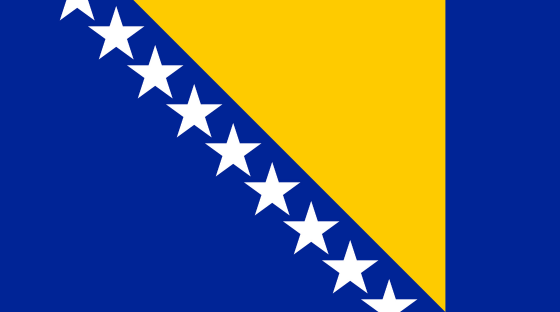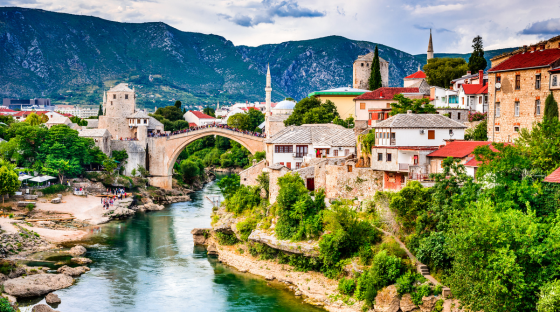Bosnia and Herzegovina

Overview
On the Balkan Peninsula in southeastern Europe, Bosnia and Herzegovina continues to struggle with internal divisions and its viability as an outsourcing destination is hampered by a severe shortfall between talent and demand. However, the country is coming into play as a satellite center for software development companies headquartered in more established European markets, such as Croatia.
The country was granted European Union candidate status in 2022 and discussion regarding possible ascension began in 2024. However, the Economist Intelligence Unit does not expect it to gain membership this decade.
Inhabited since the patheolithic age, Bosnia and Herzegovina proclaimed independence after the breakup of Yugoslavia in 1992. This triggered the Bosnian War between Bosniaks, the largest ethnic group making up about half the population, Serbs (31%) and Croats (15.4%). The conflict was resolved by a US-brokered peace agreement in 1995.
The republic’s countryside is home to medieval villages, rivers, lakes and the craggy Dinaric Alps. The capital Sarajevo has a well preserved old quarter, Baščaršija, with landmarks such as the 16th-century Gazi Husrev-bey Mosque. Its Ottoman-era Latin Bridge is the site of the assassination of Archduke Franz Ferdinand, which ignited World War I.
The Accelerance Global Network is the most curated list of high-quality global teams ever assembled.
15hrs
Time Travel (From NY)
Average flight time from NY to the major cities in the country.
29
Partner Innovation capability
The score reflects investment in STEM progrms and IT funding by country.
82
Partner Skill Level
Level of workforce skills and quality of education, including factors such as digital literacy, interpersonal skills, etc.
54
Partner Global Competitiveness
National productivity based on 12 core pillars, including government policy, infrastructure, economic stability, etc.
Medium
Software Outsourcing Readiness
Overall rating, based on the maturity of the tech sector, socio-political conditions, and on-the-ground research by Accelerance.

Talent Pool & Education
Bosnia and Herzegovina’s tech outsourcing sector is well regarded for its high-quality workforce and affordable labor, but the country suffers from a serious talent shortage, especially among senior professionals, who are often lured offshore. According to the data available to Bit Alliance, an association that brings together the country’s largest IT companies, the IT sector employs around 8,500 workers, most of whom are based in the capital, Sarajevo.
While only small numbers of students study technology at tertiary level, initiatives to reverse that trend include an incubator for entrepreneurs at the University of Sarajevo. Another key project is the UK-funded 21st Century Schools program, which is providing micro:bit devices to schools across the Western Balkans to promote critical thinking and programming skills among one million students aged 10 to 15.
In another positive move, the government has recognised the potential of the technology sector as a strategic branch of the economy in its development strategy through to 2027. Reforms in tax and education, from primary schools to higher education institutions, are being discussed.
Language
Bosnian, Croatian and Serbian are all official languages. English is not as widely spoken compared to other European countries but proficiency is increasing noticeably among the younger generation, especially in urban areas and among educated professionals.

Economic Outlook
The war in Ukraine sent energy and food prices spiraling in Bosnia and Herzegovina, and inflation reached a record 17.4% in late 2022, although that has since been brought under control. An International Monetary Fund report says the economy is showing resilience in a difficult environment and predicts an improvement in GDP to 2.5% in 2024. However, growth is expected to be slower than in most other east European economies, largely due to labor-market outflows and poor coordination of public investment projects between the country’s two entities, the Serb republic and the Muslim-Croat federation.
The key economic challenge, according to the World Bank, is the imbalance of the republic’s economic model: public policies and incentives are skewed toward the public rather than the private sector, consumption rather than investment, and imports rather than exports. Downside risks include an abrupt slowdown in Europe, increased commodity price volatility, and rising domestic political tensions. The country is fully reliant on Russian gas and is one of the few European countries that has not introduced sanctions.
To accelerate growth, the IMF says accelerated reforms are needed to improve fiscal governance, protect financial integrity, fight corruption, and step up digitalization. Transitioning from coal to green energy along with preparing for the introduction of EU carbon taxes is a major challenge ahead.
Political Conditions
Bosnia remains riven by sharp ethnic divisions, 25 years after a US-brokered peace agreement brought its bitter civil war to an end. The country is divided into two entities, the Serb republic and the Muslim-Croat federation, and is run by a three-member presidency formed by Serb, Bosniak and Croat representatives; state decisions must be jointly agreed and all have the right of veto. In practice, this has significantly hampered decision making.
In March 2024, European Union leaders decided to open accession negotiations with Bosnia and Herzegovina, eight years after the country applied to join the bloc. However, analysts do not expect it to gain membership in the near future.
Milorad Dodik, president of the Serb-majority entity Republika Srpska and leader of its ruling SNSD party, has pursued an increasingly nationalist and separatist line, invoking the right of the Bosnian Serbs to self-determination. In May 2024, he announced a plan to secede. Dodik has met several times with Russian President Vladimir Putin since the invasion of Ukraine and "confirmed the good relations" between Republika Srpska and the Russian state.
Learn more about our customer stories.
Looking for a customer story in a specific technology or industry? Discover compelling customer narratives within a specific technology or industry that resonate with your unique software development needs.

%20(1).png?width=300&name=WEBSITE%20Stop%20Chasing%20Low%20Hourly%20Rates%20Unlock%20the%20True%20Value%20of%20Offshore%20Development%20(450%20x%20253%20px)%20(1).png)




